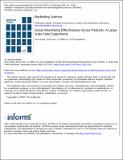Social Advertising Effectiveness Across Products: A Large-Scale Field Experiment
Author(s)
Huang, Shan; Aral, Sinan K; Hu, Yu Jeffrey; Brynjolfsson, Erik
DownloadPublished version (1.370Mb)
Publisher with Creative Commons License
Publisher with Creative Commons License
Creative Commons Attribution
Terms of use
Metadata
Show full item recordAbstract
Most of the empirical evidence on social advertising effectiveness focuses on a single product at a time. As a result, little is known about how the effectiveness of social advertising varies across product categories or product characteristics. We therefore collaborated with a large online social network to conduct a randomized field experiment measuring social ad effectiveness across 71 products in 25 categories among more than 37 million users. We found some product categories, like clothing, cars, and food, exhibited significantly stronger social advertising effectiveness than other categories, like financial services, electrical appliances, and mobile games. More generally, we found that status goods, which rely on status-driven consumption, displayed strong social advertising effectiveness. Meanwhile, social ads for experience goods, which rely on informational social influence, did not perform any better or worse than social ads for their theoretical counterparts, search goods. Social advertising effectiveness also significantly varied across the relative characteristics of ad viewers and their friends shown in ads. Understanding the heterogeneous effects of social advertising across products can help marketers differentiate their social advertising strategies and lead researchers to more nuanced theories of social influence in product evaluation.
Date issued
2020-11Department
Sloan School of ManagementJournal
Marketing Science
Publisher
Institute for Operations Research and the Management Sciences (INFORMS)
Citation
Huang, Shan et al. "Social Advertising Effectiveness Across Products: A Large-Scale Field Experiment." Marketing Science 39, 6 (November 2020): 1033-1201 © 2020 The Author(s)
Version: Final published version
ISSN
0732-2399
1526-548X